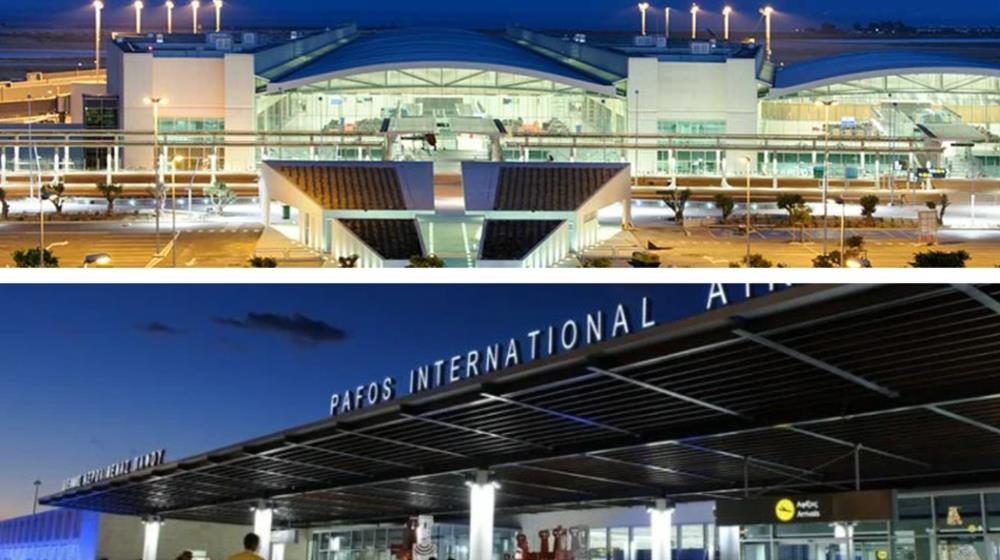Hermes Airports is planning the expansion of the two airports under their management in Larnaka and Pafos, aiming, among other things at increasing the number of passengers they serve.
Towards this direction, Hermes has commissioned the company La Solas Services Ltd to prepare an Environmental Impact Assessment (EIA) for the projects planned to be carried out at both airports, while also proceeding with public presentations of the projects and studies, so the opinions of both the local authorities and society are also recorded before their final submission to the competent state agencies for approval.
The presentation of the designs for Pafos Airport took place on 29 October at Timi community event hall, while the presentation of the designs for Larnaka Airport will take place on 30 October at the town’s House of Arts and Letters at 6pm.
The cost of projects
According to the data recorded in the drafts of the Environmental Impact Assessment, the general cost estimate for the expansion of Larnaka Airport amounts to approximately €95 million, which are distributed as follows:
- Extension of the building in the eastern part of the terminal and the western wing: €77 million
- Extension of the runway and relocation of the GSE ancillaries: €18 million
As far as the expansion projects of Pafos Airport are concerned, the general estimate of construction costs amounts to approximately €75 million, distributed as follows:
- Construction of an additional new southern parallel runway with all the necessary lighting and safety requirements: €38 million Extension of the terminal: €37 million
Larnaka Airport
Also based on the Assesments, the general purpose of the project at Larnaka Airport is to expand the existing terminal to provide capacity for the annual handling of 12 million passengers per year and to increase the capacity of the aircraft parking runway in line with the traffic mix of aircraft.
The main projects envisaged are the following:
- Extension of the terminal building to the east: At the departure level the space will be used to house departure passport control and security functions. It is considered that no additional space is required for check-in. This area will not need to be directly connected to the road network via a bridge.
- The existing passport control and security area will be re-used to provide additional commercial space, including adequate seating for the public.
- The departure gate area will be extended to the west via a connected 'wing' which will house new departure gates used for entry and exit. The intention is to design and construct the gate area at ground level. The intention is to have the technically and cost-effective possibility to add passenger boarding bridges (PBBs) and an additional floor above the new departure gates to enable connection to the potential second terminal to be built in Phase 3, according to with the general plan.
- Provision should be made for the terminal to operate in a Schengen environment while maintaining the level of peak passenger service for Schengen and non-Schengen passengers separately. This will be done by flexible use of gates and/or a second passport control for the new wing.
- The baggage claim area will be remodeled to enable the installation of two additional incoming baggage pick up belts.
- The baggage claim area will be extended to accommodate at least one outbound baggage belt with provision for the addition of another outbound baggage belt if required (activation mechanism to be agreed) with suitable baggage unloading area.
- The eastern extension of the runway will be designed to allow for a single taxiway, but in such a way that it is easy to convert to a dual taxiway configuration at a later stage.
Pafos Airport
In relation to Pafos Airport, the general purpose of the project is the construction of a complementary new southern parallel runway, with all the necessary lighting and safety requirements, as well as the expansion of the existing terminal to provide capacity suitable for the annual handling of 5 million passengers.
The main projects envisaged are the following:
- Extension of the terminal to the east with the design and construction of a space equivalent to the existing arrivals area (foreigner section and baggage claim). The new space will house the operation of the alien department in a similar space to the current one and at least 3 baggage claim units of the same or longer length as the existing one. In addition, the design of the new space will allow for the provision of a fourth baggage claim area. The installation of a fourth baggage claim area will depend on capacity requirements by the end of 2036 and a date trigger mechanism will be agreed. The area of the new terminal building to be constructed is estimated to be approximately 3,350 sq.m.
- The existing arrivals area will be re-used to house the security and alien department functions and part of the space will be reconfigured to house at least two additional passenger gates, similar to the existing gates.
- The existing security/alien department area will be repurposed to accommodate new screening area and allow for the expansion of commercial space. The coffee shop in the ground part of the airport will be moved outside.
- Commercial space should allow for more centrally located public seating.
- On the west side, a second belt will be designed for outgoing luggage.
- Demonstration of how the terminal could operate in a Schengen environment while maintaining service level C for the peak passenger load of Schengen and non-Schengen passengers separately. The main effort will be to solve the issues of the Schengen environment through biometric technology, however, a plan will also be provided on how to address this issue through the flexible use of gateways,
- The parallel runway will be fully extended to the east, while to the west it will be constructed only to the point within the perimeter of the airport area. The proposed design may include an angular connection of the runway to the runway in order to allow maximum use of the runway.
Duration of projects and personnel
Furthermore, according to the Assessments, the projects at Larnaka Airport will last approximately 30 months and at Pafos Airport 27 months.
For the projects at Larnaka Airport, it is estimated that approximately 3,600 man-months will be required to complete the construction works, i.e. an average of 150 workers during the works, while during the peak period, approximately 230 workers are expected to be on site at the same time.
In order not to affect the operation of the airport throughout the construction works (terminal and taxiway), their correct planning in stages has been foreseen.
For the projects at Pafos Airport, it is estimated that approximately 2,700 man-months will be required to complete the construction works, i.e. an average of 110 workers during the works, while during the peak period, approximately 170 are expected to be on the construction site at the same time workers.
And in this case, in order not to affect the operation of the airport throughout the construction works (terminal and taxiway), their correct planning in stages has been foreseen.
According to the Assessments, the construction workforce will be hired separately from local or foreign service providers.
Bouygues, a Hermes shareholder and head of the construction group, will be the design and construction contractor for all the new development projects, while Chapo and Iacovou Brothers, also Hermes shareholders and part of the Hermes construction group, have a sufficient labour pool to carry out most of the structural and technical/exterior works.
Bouygues will also provide any additional labor required for these and other works, which will be sourced locally (where possible) or possibly imported from EU countries.
As stated, "the construction industry in Cyprus is currently in a slump and some observers in the media have argued that the airport expansion project will provide significant employment opportunities in the area around the airport.
However, there is also a shortage of construction skills in Cyprus, so it is likely that the project will only be able to fill a small percentage of the vacancies from the existing local labour pool - the rest will come from other nationals."
The will of Hermes Airports Ltd, however, is for the contractor to employ labour from the domestic market, and to use imported labor only when either the number of workers or the skills cannot be secured from the local market.
It is noted that the public consultation on the expansion of Pafos Airport will last until 19 November and for Larnaka Airport until 20 November.
Detailed information on Hermes Airports' plans and the prepared Assessments, in Greekm can be seen HERE (PUBLIC PRESENTATIONS category).
(Source: InBusinessNews)









